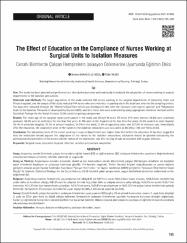| dc.contributor.author | Karagülle Koza, Emine | |
| dc.contributor.author | Yıldız, Tülin | |
| dc.date.accessioned | 2022-05-11T14:10:25Z | |
| dc.date.available | 2022-05-11T14:10:25Z | |
| dc.date.issued | 2021 | |
| dc.identifier.issn | 2587-0262 | |
| dc.identifier.issn | 2587-0262 | |
| dc.identifier.uri | https://doi.org/10.4274/nkmj.galenos.2021.47966 | |
| dc.identifier.uri | https://app.trdizin.gov.tr/makale/TkRVeE1ETTVPUT09 | |
| dc.identifier.uri | https://hdl.handle.net/20.500.11776/5394 | |
| dc.description.abstract | Aim: This study has been planned and performed as a descriptive and cross-sectional study to evaluate the adaptation of nurses working in surgicaldepartments to the isolation precautions.Materials and Methods: The target population of the study included 250 nurses working in the surgical departments of University, State andPrivate hospitals, and the sample of the study included 144 nurses who were volunteer to participate in the study and who met the sampling criteria.The data were obtained through the “Worker’s Data Form which was developed in line with the literature and experts’ opinion” and “AdaptationScale To the Isolation Precautions” developed by Tayran (2009), and then these data were evaluated by using appropriate statistical methods withinStatistical Package for the Social Sciences 22.00 statistical package programme.Results: The mean age of the surgical nurses participated in the study was 28.9±8.49 years. Of them, 91% were women, 56.3% were universitygraduate, 58.3% were in profession for less than five years, 81.9% were in the department for less than five years, 32.6% worked in state hospital,36.1% in university hospital, 31.3% in private hospitals, 34.7% in the ward, 27.8% in operating room, and 37.52% in intensive care. Immediatelyafter the education, the adaptation score of the nurses to the isolation precautions was calculated as 80.389±7.106 over 90 (p<0.05).Conclusion: The adaptation score of the nurses working in surgical departments was higher than that before the education. It has been suggestedthat the institution should support the adaptation of the nurses to the isolation precautions, education should be planned considering theprofessional characteristics of the nurses and the factors of the institution, and this training should be repeated with regular intervals. | en_US |
| dc.description.abstract | Amaç: Araştırma, cerrahi birimlerde çalışan hemşirelerin eğitim öncesi (EÖ) ve eğitim sonrası (ES) izolasyon önlemlerine uyumlarını değerlendirmek amacıyla tanımlayıcı ve kesitsel nitelikte planlandı ve uygulandı. Gereç ve Yöntem: Araştırmanın evrenini; üniversite, devlet ve özel hastanelerin cerrahi kliniklerinde çalışan 250 hemşire, örneklemi ise örneklem seçim kriterlerini karşılayan ve çalışmaya katılmaya gönüllü 144 hemşire oluşturdu. Veriler literatür bilgileri doğrultusunda ve uzman kişilerin görüşleri alınarak araştırmacılar tarafından hazırlanan ‘‘Çalışan Veri Formu’’ ve Tayran tarafından (2009) geliştirilen ‘‘İzolasyon Önlemlerine Uyum Ölçeği’’ ile toplandı. Statistical Package for the Social Sciences 22.00 istatistik paket programında, uygun istatistiksel yöntemler kullanılarak veriler değerlendirildi. Bulgular: Araştırmaya katılan hemşirelerin yaş ortalamasının 28,9±8,49 yıl, %91’inin kadın, %56,3’ünün lisans mezunu, %58,3’ünün meslekte beş yıldan daha az tecrübesi olduğu, %81,9’unun ise çalışılan birimde beş yıldan daha az çalışma süresine sahip olduğu, %32,6’sının devlet %36,1’inin üniversite, %31,3’ünün özel hastanelerde çalıştıkları, %34,7’sinin servis, %27,8’inin ameliyathane ve %37,52’sinin yoğun bakım birimlerinde çalıştığı belirlendi. Hemşirelerin ES izolasyon önlemlerine uyum düzeyi 80,389±7,106 olarak saptandı (p<0,05). Sonuç: Cerrahi birimde çalışan hemşirelerin izolasyon önlemlerine uyum puanları EÖ’ye göre, ES en yüksek bulunurken, puanın 1. ayda biraz düştüğü 3. ayda ise ES’ye göre daha da düşük olduğu belirlendi. Hemşirelerin izolasyon önlemlerine uyumları konusunda kurumsal desteğin sağlanması, hizmet içi eğitimlerde hemşirelerin mesleki özellikleri ve kurumsal faktörler dikkate alınarak planlamaların yapılması ve eğitimlerin düzenli aralıklarla tekrarlanması önerilmektedir. | en_US |
| dc.language.iso | eng | en_US |
| dc.identifier.doi | 10.4274/nkmj.galenos.2021.47966 | |
| dc.rights | info:eu-repo/semantics/openAccess | en_US |
| dc.title | The Effect of Education on the Compliance of Nurses Working at Surgical Units to Isolation Measures | en_US |
| dc.title.alternative | Cerrahi Birimlerde Çalışan Hemşirelerin İzolasyon Önlemlerine Uyumunda Eğitimin Etkisi | en_US |
| dc.type | article | en_US |
| dc.relation.ispartof | Namık Kemal Tıp Dergisi | en_US |
| dc.department | Yüksekokullar, Sağlık Yüksekokulu, Hemşirelik Bölümü | en_US |
| dc.department | Enstitüler, Sağlık Bilimleri Enstitüsü, Hemşirelik Ana Bilim Dalı | en_US |
| dc.identifier.volume | 9 | en_US |
| dc.identifier.issue | 2 | en_US |
| dc.identifier.startpage | 195 | en_US |
| dc.identifier.endpage | 200 | en_US |
| dc.institutionauthor | Karagülle Koza, Emine | |
| dc.institutionauthor | Yıldız, Tülin | |
| dc.identifier.trdizinid | TkRVeE1ETTVPUT09 | en_US |



















